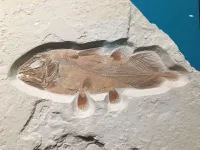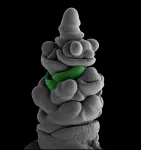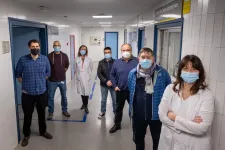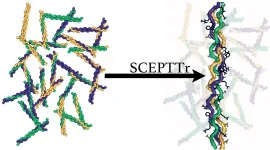Can evolution be predicted?
Scientists created a framework to test the predictions of biological optimality theories, including evolution.
2021-02-16
(Press-News.org) Scientists created a framework to test the predictions of biological optimality theories, including evolution.
Evolution adapts and optimizes organisms to their ecological niche. This could be used to predict how an organism evolves, but how can such predictions be rigorously tested? The Biophysics and Computational Neuroscience group led by professor Gašper Tkačik at the Institute of Science and Technology (IST) Austria has now created a mathematical framework to do exactly that.
Evolutionary adaptation often finds clever solutions to challenges posed by different environments, from how to survive in the dark depths of the oceans to creating intricate organs such as an eye or an ear. But can we mathematically predict these outcomes?
This is the key question that motivates the Tkačik research group. Working at the intersection of biology, physics, and mathematics, they apply theoretical concepts to complex biological systems, or as Tkačik puts it: "We simply want to show that it is sometimes possible to predict change in biological systems, even when dealing with such a complex beast as evolution."
Climbing mountains in many dimensions
In a joint work by the postdoctoral fellow Wiktor M?ynarski and PhD student Michal Hledík, assisted by group alumnus Thomas Sokolowski, who is now working at the Frankfurt Institute for Advanced Studies, the scientists spearheaded an essential advance towards their goal. They developed a statistical framework that uses experimental data from complex biological systems to rigorously test and quantify how well such a system is adapted to its environment. An example of such an adaptation is the design of the eye's retina that optimally collects light to form a sharp image, or the wiring diagram of a worm's nervous system that ensures all the muscles and sensors are connected efficiently, using the least amount of neural wiring.
The established model the scientists base their results on represents adaptation as movement on a landscape with mountains and valleys. The features of an organism determine where it is located on this landscape. As evolution progresses and the organism adapts to its ecological niche, it climbs towards the peak of one of the mountains. Better adaptation results in a better performance in the environment - for example producing more offspring - which in turn is reflected in a higher elevation on this landscape. Therefore, a falcon with its sharp eyesight is located at a higher point than the bird's ancestor whose vision was worse in the same environment.
The new framework by M?ynarski, Hledík, and colleagues allows them to quantify how well the organisms are adapted to their niche. On a two-dimensional landscape with mountains and valleys, calculating the elevation appears trivial, but real biological systems are much more complex. There are many more factors influencing it, which results in landscapes with many more dimensions. Here, intuition breaks down and the researchers need rigorous statistical tools to quantify adaptation and test its predictions against experimental data. This is what the new framework delivers.
Building bridges in science
IST Austria provides a fertile ground for interdisciplinary collaborations. Wiktor M?ynarski, originally coming from computer science, is interested in applying mathematical concepts to biological systems. "This paper is a synthesis of many of my scientific interests, bringing together different biological systems and conceptual approaches", he describes this most recent study. In his interdisciplinary research, Michal Hledík works with both the Tkačik group and the research group led by Nicholas Barton in the field of evolutionary genetics at IST Austria. Gašper Tkačik himself was inspired to study complex biological systems through the lens of physics by his PhD advisor William Bialek at Princeton University. "There, I learned that the living world is not always messy, complex, and unapproachable by physical theories. In contrast, it can drive completely new developments in applied and fundamental physics," he explains.
"Our legacy should be the ability to point a finger at selected biological systems and predict, from first principles, why these systems are as they are, rather than being limited to describing how they work," Tkačik describes his motivation. Prediction should be possible in a controlled environment, such as with the relatively simple E. coli bacteria growing under optimal conditions. Another avenue for prediction are systems that operate under hard physical limits, which strongly constrain evolution. One example are our eyes that need to convey high-resolution images to the brain while using the minimal amount of energy. Tkačik summarizes, "Theoretically deriving even a bit of an organism's complexity would be the ultimate answer to the 'Why?' question that humans have grappled with throughout the ages. Our recent work creates a tool to approach this question, by building a bridge between mathematics and biology."
INFORMATION:
[Attachments] See images for this press release:

ELSE PRESS RELEASES FROM THIS DATE:
2021-02-16
Fossilised remains of a fish that grew as big as a great white shark and the largest of its type ever found have been discovered by accident.
The new discovery by scientists from the University of Portsmouth is a species of the so-called 'living fossil' coelacanths which still swim in the seas, surviving the extinction that killed off the dinosaurs.
The discovery was purely serendipitous. Professor David Martill, a palaeontologist from the University's School of the Environment, Geography and Geosciences, had been asked to identify a large ...
2021-02-16
In plants, the "meristem" refers to a type of tissue comprising undifferentiated cells from which various other plant organs can develop through cell division and differentiation. These "plant stem cells" give rise to shoots, leaves and roots, but also spikes and flowers.
The research team including members of the Cluster of Excellence on Plant Sciences CEPLAS investigated the function of a gene responsible for the different spike forms of wheat and barley. This gene controls the activity of the spike and floret meristems and thus the number of spikelet ...
2021-02-16
The research team that developed a biosensor that first recorded that a distinct gradient of the plant growth hormone gibberellin correlated with plant cell size has now revealed how this distribution pattern is created in roots.
Starting when a plant embryo forms within a seed and continuing throughout the plant lifecycle, undifferentiated stem cells undergo radical transformations into specialised root, stem, leaf and reproductive organ cells. This transformation relies on a suite of molecules called phytohormones that, much like human hormones, can move between cells and tissues and trigger distinct biological processes across the bodyplan. While it was not known at the time, mutations involving the gibberellin class of ...
2021-02-16
PITTSBURGH, Feb. 15, 2021 - Why do patients who receive antipsychotic medications to manage schizophrenia and bipolar disorder quickly gain weight and develop prediabetes and hyperinsulemia? The question remained a mystery for decades, but in a paper published today in Translational Psychiatry, researchers from the University of Pittsburgh School of Medicine finally cracked the enigma.
Antipsychotic drugs, scientists showed, not only block dopamine signaling in the brain but also in the pancreas, leading to uncontrolled production of blood glucose-regulating hormones and, eventually, obesity and diabetes.
"There are dopamine theories of schizophrenia, drug addiction, depression and neurodegenerative disorders, and we are presenting a dopamine theory of metabolism," said lead ...
2021-02-16
For more than a decade, governments in countries across the world have made significant progress to expand their protected areas network to conserve the planet's biodiversity. According to a new study published in the journal Global Change Biology, the locations of these protected areas do not take into account the potential long-term effects of climate change in these protected areas.
Creating and managing protected areas, such as national parks, is key for biodiversity conservation. As the climate changes, however, species will disperse in order to maintain their specific habitat needs. Species that were in protected areas ...
2021-02-16
Almost half the patients admitted to an intensive care unit (ICU) require invasive mechanical ventilation (IMV), a medical procedure that guarantees a sufficient supply of oxygen to their organs and tissues. The therapy involves connecting patients to a machine that substitutes their spontaneous breathing. In recent months it has been in general use in intensive-care patients affected by COVID-19.
Although it can often save a patient's life, invasive mechanical ventilation is not risk-free: there can be accidental injury during intubation or extubation or the muscles ...
2021-02-16
A NEW study from the University of Chichester has shed light on how people coped psychologically with the sudden and life-changing disruption caused by COVID-19.
This new publication, by Chichester's Professor Laura Ritchie and PhD candidate Benjamin Sharpe, in collaboration with Professor Daniel Cervone of the University of Illinois at Chicago, provides a unique snapshot into people's understanding of their goals and self-beliefs amidst a shared, unexpected alteration of the daily landscape during lockdown.
Ritchie and colleagues collected their ...
2021-02-16
HOUSTON - (Feb. 15, 2021) - Collagen is the king of biological proteins, and now it has a SCEPTTr.
That's the handle of an algorithm developed by Rice University scientists who study natural and synthetic versions of collagen, which accounts for about a third of the body's proteins and forms the fibrous glue in skin, bones, muscles, tendons and ligaments.
The program -- full name, Scoring function for Collagen-Emulating-Peptides' Temperature of Transition -- accurately predicts the stability of collagen triple helices, the primary structure that forms fibrils.
The Rice team led by chemist and bioengineer Jeffrey ...
2021-02-16
According to some estimates, chronic pain affects up to 40% of Americans, and treating it frustrates both clinicians and patients--a frustration that's often compounded by a hesitation to prescribe opioids for pain.
A new study from the University of Michigan School of Dentistry confirms that a low dose of a drug called naltrexone is a good option for patients with orofacial and chronic pain, without the risk of addiction, said first author Elizabeth Hatfield, a clinical lecturer in the Department of Oral and Maxillofacial Surgery and Hospital Dentistry.
Naltrexone is a semisynthetic opioid first developed in ...
2021-02-16
HOUSTON - (Feb. 15, 2021) - Rice University engineers have suggested a colorful solution to next-generation energy collection: Luminescent solar concentrators (LSCs) in your windows.
Led by Rafael Verduzco and postdoctoral researcher and lead author Yilin Li of Rice's Brown School of Engineering, the team designed and built foot-square "windows" that sandwich a conjugated polymer between two clear acrylic panels.
That thin middle layer is the secret sauce. It's designed to absorb light in a specific wavelength and guide it to panel edges lined with solar cells. Conjugated polymers are chemical compounds ...
LAST 30 PRESS RELEASES:
[Press-News.org] Can evolution be predicted?
Scientists created a framework to test the predictions of biological optimality theories, including evolution.








